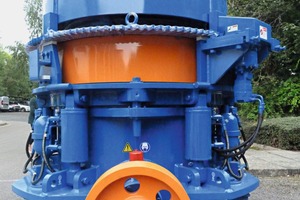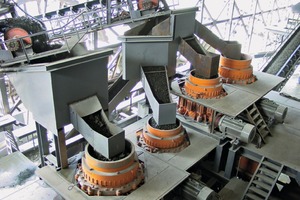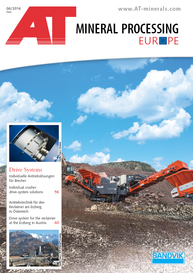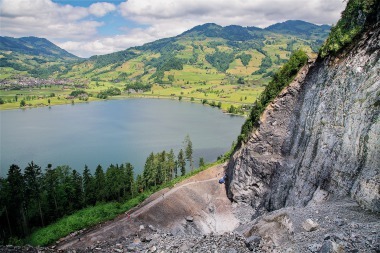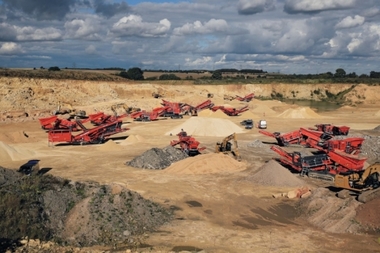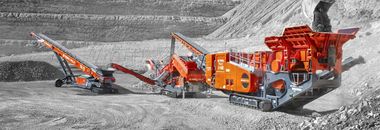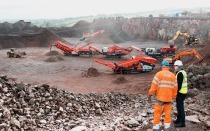The Heart of the Quarrying Process
Crushers, more than any other piece of equipment, are exposed to the high-impact work in the quarrying process. Erik Vanderkuij, Director Sales and Marketing Comminution at Weir Minerals Europe explains why it is so important to get crusher selection right.
To take the raw run-of-quarry feed and convert it into a range of graded products that are ready for sale will often require multiple crushing stages, each delivering a slightly finer product than the last. Crushers are the pieces of equipment that endure the highest level of impact in the process. Impacting large particles of rock with enough force to break them into smaller particles is a rugged job. Due to the wide range of duties they encounter, from processing the large, irregular particles that come directly from the ground to processing fine particles to deliver accurately-graded end products, crushers vary significantly in size and design.
It is critical to ensure crushers are adequately suited to the feed they are handling, because making the wrong choice can prove costly. An incorrect selection may jam regularly, get through wear parts rapidly or consume large amounts of energy.
The two crusher types most commonly found at quarries are jaw crushers and cone crushers (Fig. 1).
Jaw Crushers
Jaw crushers are ideal for primary crushing applications. The first stage in the process of reducing the large pieces of rock to a more manageable size for further processing and transportation. The machine uses compressional forces, generated between a fixed jaw and a second moving jaw, attached to an eccentric shaft powered by a large flywheel. The small aperture between the bottom edges of the two jaws determines the maximum size of particle that is able to pass through the crusher.
It is vital to have a fail-safe system to prevent high-pressure jamming or damage to the jaws in the event of an uncrushable object entering the system. This is achieved by the use of a ‘toggle plate’, which holds the moving jaw at the correct angle. It is easy and quick to replace and prevents costly damage or hazardous jamming.
The Trio® range of jaw crushers from Weir Minerals feature hydraulic adjustment systems that allow the jaw discharge opening to be set and adjusted rapidly, which reduces costly down-time. For quarrying-specific applications, the Trio® MS jaw crusher from Weir Minerals is one of the most advanced units on the market, featuring a very large feed opening and long jaws that deliver robust strokes for reliable primary crushing.
Cone Crushers
Cone crushers offer higher throughput of particles that are smaller and more regular size than jaw crushers and are mainly used for secondary or tertiary crushing duties (Fig. 2). The machine works by crushing the feed between the surfaces of two cones, the gap between which narrows towards the rim at the bottom. The size of this gap determines the maximum particle size that can travel through the crusher. The upper surface is known as the concave and the lower as the mantle.
Pre-crushed product enters the crusher at the top and falls down over the mantle, the base of which rotates eccentrically, crushing the material against the concave above. Particles that have been crushed small enough to pass through the gap at the bottom of the mantle then fall away and are transported on for further processing.
All cone crushers face the common risk that some particles that cannot be crushed may enter the crushing chamber with the feed. To allow these situations to be rectified easily, the upper section of the crusher is suspended and can be lifted off the mantle to increase the gap between the two and allow the large object to pass. This process also enables the grade of the crushed product to be adjusted and provides access when liners need to be replaced.
The ease and speed of the operation is a key consideration when specifying a cone crusher. The crusher selection can have a significant impact on the loss of productivity that can be incurred if there is a breakdown when adjusting the unit or when conducting regular maintenance. The latest generation of the Trio® TC series and Trio® T series cone crushers from Weir Minerals features automated hydraulic adjustment aids that allow the upper part of the crusher to be adjusted or lifted away quickly and efficiently by a single operator. The system also allows adjustments to be made whilst the plant is running, removing the need to stop operations for minor changes in cone height.
Liner Selection
The high-impact and abrasive nature of crushing means that wear to the parts exposed to the rock is unavoidable. It can, however, be controlled by making careful selection of the liner material used in a cone crusher. This is an important consideration because the cost of the replacement liner and the down-time required to make the replacement can be significant to the business. To ensure the crushing process is effective, the surfaces of the mantle and concave need to be hard in order to withstand high levels of abrasion and pressure from the crushing action. The preferred liners material is steel instead of rubber. Harder steels containing manganese are preferred, although it is important not to use steel that has been hardened to the extent that it may crack upon impact, rather than abrade.
More abrasion-resistant liners mean a higher initial outlay, but less frequent need for replacement. The business case for installing the most resistant and consequently expensive liners generally depends on the how abrasive the duties are. The level of silica in the process material should indicate the abrasive level. Typically, low silica-content materials such as limestone have lower wear costs while sandstone, sand and gravel require more frequent parts replacement.
There are many factors that go into determining the whole-life cost of a crusher, including fuel and maintenance costs. It is important to consult with manufacturers to determine the combination of crushers and liners that will deliver the most efficient performance over the life of the unit.
$(LEhttp://

